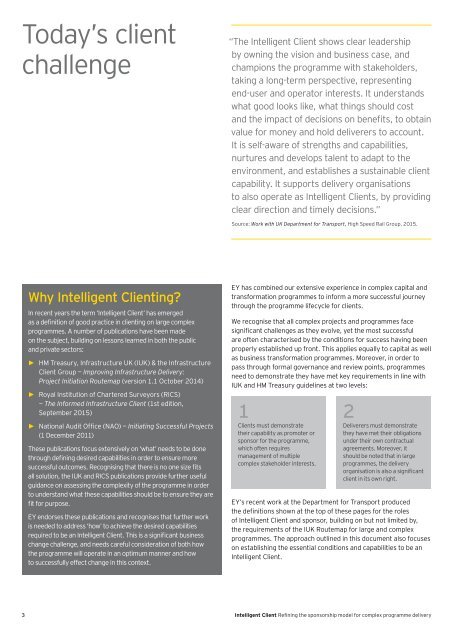EY-Intelligent-Client-strategic-sponsorship
EY-Intelligent-Client-strategic-sponsorship
EY-Intelligent-Client-strategic-sponsorship
Create successful ePaper yourself
Turn your PDF publications into a flip-book with our unique Google optimized e-Paper software.
Today’s client<br />
challenge<br />
“The <strong>Intelligent</strong> <strong>Client</strong> shows clear leadership<br />
by owning the vision and business case, and<br />
champions the programme with stakeholders,<br />
taking a long-term perspective, representing<br />
end-user and operator interests. It understands<br />
what good looks like, what things should cost<br />
and the impact of decisions on benefits, to obtain<br />
value for money and hold deliverers to account.<br />
It is self‐aware of strengths and capabilities,<br />
nurtures and develops talent to adapt to the<br />
environment, and establishes a sustainable client<br />
capability. It supports delivery organisations<br />
to also operate as <strong>Intelligent</strong> <strong>Client</strong>s, by providing<br />
clear direction and timely decisions.”<br />
Source: Work with UK Department for Transport, High Speed Rail Group, 2015.<br />
Why <strong>Intelligent</strong> <strong>Client</strong>ing?<br />
In recent years the term ‘<strong>Intelligent</strong> <strong>Client</strong>’ has emerged<br />
as a definition of good practice in clienting on large complex<br />
programmes. A number of publications have been made<br />
on the subject, building on lessons learned in both the public<br />
and private sectors:<br />
►►<br />
HM Treasury, Infrastructure UK (IUK) & the Infrastructure<br />
<strong>Client</strong> Group — Improving Infrastructure Delivery:<br />
Project Initiation Routemap (version 1.1 October 2014)<br />
►►<br />
Royal Institution of Chartered Surveyors (RICS)<br />
— The Informed Infrastructure <strong>Client</strong> (1st edition,<br />
September 2015)<br />
►►<br />
National Audit Office (NAO) — Initiating Successful Projects<br />
(1 December 2011)<br />
These publications focus extensively on ‘what’ needs to be done<br />
through defining desired capabilities in order to ensure more<br />
successful outcomes. Recognising that there is no one size fits<br />
all solution, the IUK and RICS publications provide further useful<br />
guidance on assessing the complexity of the programme in order<br />
to understand what these capabilities should be to ensure they are<br />
fit for purpose.<br />
<strong>EY</strong> endorses these publications and recognises that further work<br />
is needed to address ‘how’ to achieve the desired capabilities<br />
required to be an <strong>Intelligent</strong> <strong>Client</strong>. This is a significant business<br />
change challenge, and needs careful consideration of both how<br />
the programme will operate in an optimum manner and how<br />
to successfully effect change in this context.<br />
<strong>EY</strong> has combined our extensive experience in complex capital and<br />
transformation programmes to inform a more successful journey<br />
through the programme lifecycle for clients.<br />
We recognise that all complex projects and programmes face<br />
significant challenges as they evolve, yet the most successful<br />
are often characterised by the conditions for success having been<br />
properly established up front. This applies equally to capital as well<br />
as business transformation programmes. Moreover, in order to<br />
pass through formal governance and review points, programmes<br />
need to demonstrate they have met key requirements in line with<br />
IUK and HM Treasury guidelines at two levels:<br />
1<br />
<strong>Client</strong>s must demonstrate<br />
their capability as promoter or<br />
sponsor for the programme,<br />
which often requires<br />
management of multiple<br />
complex stakeholder interests.<br />
2<br />
Deliverers must demonstrate<br />
they have met their obligations<br />
under their own contractual<br />
agreements. Moreover, it<br />
should be noted that in large<br />
programmes, the delivery<br />
organisation is also a significant<br />
client in its own right.<br />
<strong>EY</strong>’s recent work at the Department for Transport produced<br />
the definitions shown at the top of these pages for the roles<br />
of <strong>Intelligent</strong> <strong>Client</strong> and sponsor, building on but not limited by,<br />
the requirements of the IUK Routemap for large and complex<br />
programmes. The approach outlined in this document also focuses<br />
on establishing the essential conditions and capabilities to be an<br />
<strong>Intelligent</strong> <strong>Client</strong>.<br />
3 <strong>Intelligent</strong> <strong>Client</strong> Refining the <strong>sponsorship</strong> model for complex programme delivery



